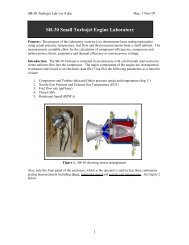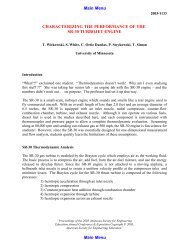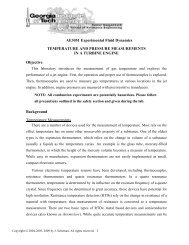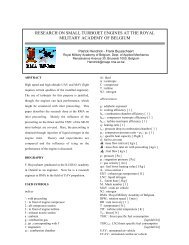Soft Computing Applications on SR-30 Turbojet Engine
Soft Computing Applications on SR-30 Turbojet Engine
Soft Computing Applications on SR-30 Turbojet Engine
Create successful ePaper yourself
Turn your PDF publications into a flip-book with our unique Google optimized e-Paper software.
AIAA 2004-644415, the result from the sec<strong>on</strong>d attempt is shown. Asteady state was achieved in about 5.0 sec<strong>on</strong>ds with anear no-steady error. Although the settling time wasl<strong>on</strong>ger than the <strong>on</strong>e observed in the simulati<strong>on</strong> using thePID c<strong>on</strong>troller, the performance of the fuzzy c<strong>on</strong>trollerfor this case showed an improvement over the first case.Figure 15 shows a good agreement with the simulati<strong>on</strong>result shown in Figure 12.to Pearl’s treatment of the subject [4]. The specificBBN approach to be employed in this effort is shown inFigure 16 and its basic procedure is bey<strong>on</strong>d the scope ofthis paper. The basic steps are listed below.λ X (u)Uπ X (u)Thrust [lbs] and Vavle Positi<strong>on</strong> [deg]5.04.54.03.53.02.52.01.51.0desired thrustthrustvalve positi<strong>on</strong>161 163 165 167 169 171 173 175Time [sec]Figure 15: Step Resp<strong>on</strong>se from <strong>SR</strong>-<strong>30</strong> <strong>Engine</strong> Case 2V. BAYESIAN BELIEF NETWORKSCONTROLLER DESIGN [2]For the engine start phase, the primary softcomputing technology to be utilized is Bayesian beliefnetworks (BBN). The sole intent of the BBN is toqualify each of the states during engine start-up prior toreaching main-stage. This will further assure certaintyin the health of the engine and proceeding into mainstagein additi<strong>on</strong> to providing added assurance intopreventing any premature engine shutdowns.BBN’s have been proven to be good predictive anddiagnostic mechanisms for reas<strong>on</strong>ing about the state ofevents in envir<strong>on</strong>ments where uncertainty is universal.Suppressing the details, the genealogy of this SCT isstr<strong>on</strong>gly rooted in classic statistical Bayesian inferencetheory where a subjectivist viewpoint is taken. In shortBayesian inference uses a different interpretati<strong>on</strong> ofprobability where <strong>on</strong>e’s degree of belief in some eventis part of the reas<strong>on</strong>ing. BBN’s are computati<strong>on</strong>alarchitectures that permit declarative (prior c<strong>on</strong>diti<strong>on</strong>alprobabilistic values) and subjective opini<strong>on</strong>s (posteriorprobabilistic values) about world (factual) knowledge tobe part of the reas<strong>on</strong>ing and assessment through avisual network representati<strong>on</strong> and a unique syntacticmessage-passing feature. Furthermore, the visualnetwork makes it easier to view the top-down cause andeffect (or c<strong>on</strong>diti<strong>on</strong> to c<strong>on</strong>sequence) relati<strong>on</strong>ships. For amore detailed account of this SCT, the reader is referred8American Institute of Aer<strong>on</strong>autics and Astr<strong>on</strong>auticsV X WYλ Y (x)π Y (x)π Z (x)λ Z (x)Figure 16 Bayesian Belief Network1. Belief Updating – When node X is activated toupdate its parameters for belief updating, it firstinspects all messages transmitted to it by its parent (π)and its children nodes (λ). Then using all input, itupdates its belief.2. Bottom-up Propagati<strong>on</strong> – Using messagestransmitted by Y&Z, compute message to transmit toparent node U.3. Top-down Propagati<strong>on</strong> – Node X then computesnew messages to be sent to its children nodes Y&Z.A first design of the Bayesian Belief Networks forthe <strong>SR</strong>-<strong>30</strong> <strong>Engine</strong> is presented in the Figure 17a and17b. Table 4 gives the initial design for the BBNalgorithm.LegendVirtual NodeUnidirecti<strong>on</strong>al BeliefPropagati<strong>on</strong>Bidirecti<strong>on</strong>al BeliefPropagati<strong>on</strong>C<strong>on</strong>tinuati<strong>on</strong>Boundary BetweenSequence &Belief NetworkAirSwitchFuelSwitch<strong>Engine</strong>Vibrati<strong>on</strong>Oil/FuelLeakageSwitchStatusIgniti<strong>on</strong>Switch3 Sec.TimerTempLimitsMasterKeySwitch<strong>Engine</strong>StartInitiatedTerminate<strong>Engine</strong>Start Seq.Figure 17a Bayesian Belief Networks for<strong>SR</strong>-<strong>30</strong> Turbo Jet <strong>Engine</strong> Start-UpThe design required analysis of the engine-start dataand careful choice of the parameters for the design. ForZOilPressureFuelSwitchElectricMasterSwitch<strong>Engine</strong>StartInitiated









